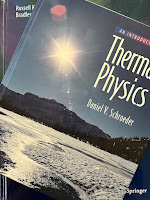The First Law
We state the first law on page 58.The most general way the energy of a system can change [ΔU] is to have both work [W] done by the system and heat [Q] flow into the system. The statement of the conservation of energy in that case is called the first law of thermodynamics: ΔU = Q − W.
The Second Law
 |
| The 2nd Law, by Peter Atkins. |
The total entropy [of a system] remains the same or increases. This is one form of the second law of thermodynamics. For a fascinating discussion of the second law, see Atkins (1994).
The book we cite by Peter Atkins, The 2nd Law: Energy, Chaos and Form (Scientific American, 1994) is excellent and I highly recommend it.
 | |
| An Introduction to Thermal Physics, by Daniel Schroeder. |
In deriving the limit… on the efficiency of an engine, we used both the first and second laws of thermodynamics. The first law told us that… we can’t get more work out than the amount of heat put in. In this context, the first law is often paraphrased, “You can’t win.” The second law, however, made matters worse. It told us that we can’t even achieve [an efficiency of one, meaning all the heat is converted to work] unless [the heat engine operates between a cold reservoir at zero absolute temperature and a hot reservoir at an arbitrarily high absolute temperature], both of which are impossible in practice. In this context, the second law is often paraphrased, “You can’t even break even.”The second law is one of the most famous principles of science. In his book The Two Cultures, C. P. Snow writes
A good many times I have been present at gatherings of people who, by the standards of the traditional culture, are thought highly educated and who have with considerable gusto been expressing their incredulity at the illiteracy of scientists. Once or twice I have been provoked and have asked the company how many of them could describe the Second Law of Thermodynamics. The response was cold: it was also negative. Yet I was asking something which is the scientific equivalent of: Have you read a work of Shakespeare’s?
The Third Law
Russ and I don’t state the third law of thermodynamics, but it is inherent in the definition of entropy we give on page 62.
The entropy S is defined by S = kB ln Ω.In this equation, kB is Boltzmann's constant and Ω is the number of possible states of the system.
Here is what Schroeder writes.
At zero temperature [absolute zero] a system should settle into its unique lowest-energy state, so [the number of states is one] and [the entropy, which is proportional to the logarithm of the number of states, is therefore zero]. This fact is often called the third law of thermodynamics.
The third law was discovered by the German physicist Walther Nernst, whose Nernst equation for the equilibrium potential across a membrane plays such a big role IPMB’s analysis of bioelectricity.
Summary
To summarize, the three laws of thermodynamics are
- Energy is conserved
- Entropy increases
- The entropy is zero at absolute zero.



No comments:
Post a Comment